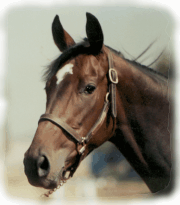|
|
|
A
Horse of Course
with Don Blazer
|
 |
It was just one of
those days. Or, in this case, nights.
Just over 227 years ago, Paul Revere rode into history.
But as a lot of history, it wasn't reported very accurately. Not until
Paul confessed at age 63 that his ride on April 16, 1775, was a disaster.
His supposedly wild gallop from Boston to Concord to warn, "The British
are coming," was really a slow stroll into a trap, which led to his
capture
by the British, which led to his failure to warn the Minutemen of Concord,
which led to the loss of his horse, which didn't even belong to him.
Paul had accepted his mission impossible and when he saw two lights
appear in the church belfry he knew the British were crossing the Charles
River and he was to go to Lexington first, then Concord.
Deacon Larkin loaned his chestnut Narragansett Pacer to Paul for the
ride. Although he never knew her name, he described her as a "very
good
horse."
The Narragansett Pacer was unquestionably the most popular saddle horse
in America at the time. Bred in Rhode Island in lush pastures bounded
by the
Atlantic and Narragansett Bay, the horses were on the small size, had
good
dispositions, great endurance, good manners and an ambling gait. Their
gait
made them very pleasant to ride even though they did not always pace--move
both legs on the same side at the same time.
This hearty little horse was much in demand by Caribbean planters who
rode the sugarcane fields supervising their labor. The horse became a
major
economic influence on Rhode Island life. But by the time of the Civil
War, a
hundred years later, the breed was virtually extinct, a victim of
mechanization and population growth.
As Paul rode along at an ambling pace, he was spotted by two British
soldiers who immediately pursued him. He escaped when one soldier rode
his
horse into a pond and his companion stopped to help.
Revere arrived in Lexington in time to warn Samuel Adams and John
Hancock, then he and Sam Dawes decided to ride on to Concord. They weren't
in much of a hurry as they were averaging about 5 miles an hour. (A horse
normally walks four miles per hour.)
Fortunately for the American Revolution, Paul and Sam met Dr. Samuel
Prescott who was on his way home to Concord after courting a young lady,
not
making a house on horse call.
As they rode along, Dawes left the road to alert the occupants of a farm
house. While he was gone four British soldiers captured Dr. Prescott and
Paul. Prescott saw an opportunity to escape, put his spurs to his horse,
raced across a pasture, jumped a stone wall and was off into the night.
Revere tried to escape in the other direction, but raced head-on into
six
more British soldiers. He was recaptured.
Dawes heard the commotion and galloped off toward Concord, but fell from
his horse and was captured.
Revere and the six soldiers started back for Lexington. After about a
mile the commanding officer, Maj. Mitchell, ordered Paul to give his horse
to
a sergeant whose horse was tired. Paul did so, and was left to walk home.
The British soldiers rode on to Lexington in time to retreat with their
fellow redcoats.
What happened to the Narragansett Pacer Revere rode that night is not
known.
However, it is a good bet Prescott was also riding a Narragansett Pacer,
and he did reach Concord, spreading the word of the British advance. The
minutemen were alerted and fired the shot heard around the world.
Paul did not relate the true details of his ride for 23 years. He was
just a bit embarrassed.
Of course poet Henry Wadsworth Longfellow made the ride a heroic
adventure in his poem the Midnight Ride of Paul Revere. And it was heroic,
even if not successful.
|

